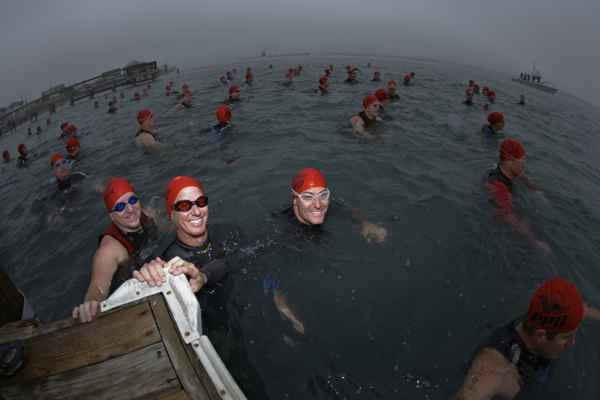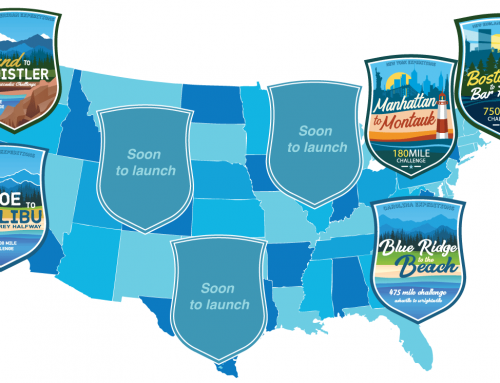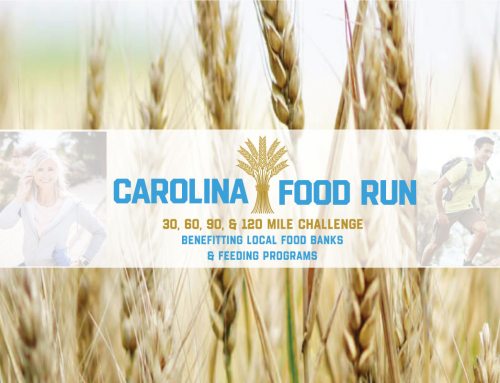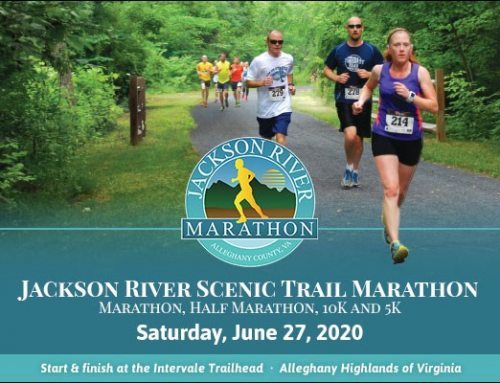
Swimmers in the PPD Beach2Battleship Triathlon prepare to compete in a competition named one of the best iron distance events in the world by Triathlete magazine. The PPD Beach2Battleship Triathlon is just one of the many reasons North Carolina is an amazing place for triathletes to live and train. Participants from 12 nations and 41 states competed in the event in 2011 alone.
While the handful of triathlons that existed in North Carolina in the early 1990s showed at least some interest in multisport, it was the already thriving swimming, cycling, and running scene that led Cid Cardoso, Jr., to believe that with a little push, he could help the sport of triathlon continue to grow. Back then, there were only a few triathlons around the state and region, all within driving distance of Raleigh, but the number of participants was stagnant. In addition, “triathletes” had to go to running-specific stores and bike shops to get their equipment, which was OK for about 60% of their needs, but as triathlon quickly became a magnet for innovation, Cardoso knew that he could create a successful one-stop shop where triathletes could not only find the products they needed but also the advice and technical information that would help them improve and further enjoy the sport. So, in December 1993, Cardoso stepped in to fill the void and founded Inside-Out Sports. Endurance Magazine recently tapped into Cardoso’s nearly 20 years of experience operating Inside-Out Sports to get his view on “the state of triathlon” in North Carolina.
EM: How have the people entering the sport of triathlon changed since 1993?
Triathlons are much more mainstream today because they are more accessible to everyone. I mean this as a positive thing, and a reason why the sport continues to experience a steady growth. In the early ’90s, it was much more difficult to “be” a triathlete. It was difficult to find information about races, obtain training plans, meet training partners, and get the equipment we needed. This meant that we probably had to be really determined to get into the sport, and that probably left a lot of potential athletes out. Just getting race-entry forms could be a challenge, as there was no such thing as online registration. We had to know where to look and who to ask. There weren’t as many races in the area so we often had to drive further and make a point of doing the ones available. Races with pool swims were also not as popular so we had to deal with open-water swims with practically every race. Finally, I think that the little media that the sport received also contributed to the image that a triathlete was the same as a Hawaii Ironman athlete, giving the impression that the sport was only for the freaks and not for everyone.
Today, triathletes are probably more “normal” and more well-rounded. People see triathlons as a way to get fit and stay motivated. This approach includes more individuals and is longer-term oriented. Most triathletes maybe do one or two triathlons per year, but they belong to training groups, follow basic workout plans, and are not in it to go to USAT Nationals or qualify for the Hawaii Ironman. They are still committed athletes and have embraced this great sport as a way of life, and their positive energy encourages others to get involved no matter their level of ability or background.
EM: You describe today’s triathletes as more “normal” people who do one or two triathlons as year. What does North Carolina have to offer the typical age-grouper?
The combination of a good economy (professional working opportunities) and good family life (good schools, safe environment, variety of entertainment) with good roads, abundance of pools, and unbelievable parks and greenways. For amateur athletes, the life outside the sport is just as important. We have to be able to earn a living and raise a family and do so in a sustainable way. The Triangle is constantly placing in the top 10 places to live in the nation when a balance between work, play, and health are considered, so it’s no surprise that triathletes like living here.
It is also important for amateur athletes to be able to train efficiently without spending too much time driving around or fighting traffic. Even though the area has grown quite a bit in the last 10 years, I can still ride “out of town” in 10 minutes and have quick access to nice and safe country roads. I have a choice of indoor and outdoor pools within 10 miles of my house and have access to probably two of the best places in the country to run: Umstead Park and the American Tobacco Trail.
EM: There are quite a few really good age-groupers participating in North Carolina triathlons, but there are a lot of elite athletes training and racing here, too. What does North Carolina have to offer professional athletes?
I think that professional athletes look for some of the same attributes mentioned above in a geographical area. Many young professional athletes are at least partially supported by the spouse, at least in the beginning of their careers, so being in an economic vibrant area is still important. It also gives them greater access to potential corporate sponsors and possibly universities for advanced studies.
Professional athletes, however, also have additional concerns. Weather that allows year-round training is often paramount, as are good coaching and training partners. The Triangle area now offers both. The local climate, although a little cold in the winter and a little hot in the summer, is still more favorable for training than 80% of the rest of the country. As far as coaching and other training partners, this area not only offer some of the most knowledgeable and experienced triathlon coaches in the country in people like Dave Williams, Alex McDonald, Stacey Richardson, and Marty Gaal, among others, but is the home base for rising pros such as Justin Park and James Duff. Besides multisport athletes, the concentration of universities fosters a large pool of collegiate and national-level athletes in the single sports of swimming, cycling, and running, who can and often do serve as training partners.
Finally, these athletes look for access to good races and a major airport to make flying easy. Although North Carolina offers a huge number of races, not many offer prize money, so our local pros normally use our races mainly as training races. I’m sure they would love to see more prize money, or races with bigger and more competitive pro fields. As far as an airport, even though RDU is not a major hub, it is easy to get in and out quick and find a variety of flights, making it at least acceptable when it comes to traveling a lot.
EM: In terms of climate and terrain, is North Carolina a good place to train?
For the most part, the climate and terrain are quite good for training. It never gets that cold so we can ride year-round. Even when it gets down to 20s, it rarely stays there for more than a day and riding in 36-degree weather is quite bearable with the right gear. I think we can all agree that spring and fall in the Carolinas are tough to beat when it comes to training. Summer can be a little challenging, especially when we get 90 days over 90 degrees. The key is to plan and adjust. Work out earlier in the morning if possible, plan to have liquids on hand, and adjust the running splits for the greater effort required. I’ve learned to accept and expect 90-degree days so I no longer dread them. In fact, I now mostly look forward to them.
For the terrain, I wish we had big mountains close by, but the rolling hills are still great for training. They offer variety and a good mix between hard routes and fast routes. Plus, we can find five-mile-plus climbs within a three-hour drive and we can reach the beach in two hours by car (or six by bike, which happens to be one of my favorite rides).
EM: As someone who has competed at Kona many times, do you think North Carolina is a good place to train for that race?
Definitely yes. Kona is hot and humid, much like the North Carolina summers. The terrain in Kona is rolling and although more desolate, not much harder than what we have around here. Plus, if we want windy conditions, we can just head to the coast. The main problem in training for the Hawaii Ironman in North Carolina is that by October the weather here is already getting quite nice (meaning less hot and humid). In September we get some beautiful end-of-summer/fall days, when it’s actually pleasant to go running without getting drenched in sweat. The trick is not to forget how those summer days felt like so when we get to Kona in October, we’re physically and mentally prepared for the race.
EM: Where are your favorite places to run, bike and swim?
As far as swimming, I’m fortunate that my wife works at SAS (one of those best companies to work for in the U.S.) so I get to use their pool on a regular basis. Not only does the pool have 10 lanes so it is rarely crowded but at lunchtime on Mondays and Fridays they offer organized masters workouts (where my wife gets to kick my butt on a weekly basis).
For riding, I enjoy Big Woods and the roads around the old Duke Liver Half Ironman course, where there are few intersections, few cars, good pavement, endless rolling hills, and beautiful scenery. My favorite ride, though, is still the 145 miles from Inside-Out Sports in Cary to the Oceanic Pier in Wrightsville Beach.
For running it’s definitely Umstead Park. Its countless miles of bridle and single-track trail are a runner’s paradise. The park offers variety and beauty in a location accessible from anywhere in the Triangle. I have friends in Boulder who have run at Umstead Park and say they can’t get that kind of running out West.
EM: What changes do you see in the sport of triathlon in North Carolina moving forward?
I see the sport continuing to grow in North Carolina and nationwide at perhaps a slightly slower but still steady rate. I do see some changes, though, for the sport in the state and in general.
There will be a consolidation of races. Some races have become too expensive to produce due to increase in local traffic and police costs and others are seen as causing too much havoc on the local population. Some are not attracting numbers to make it financially feasible and some take place in the same weekend as five other races. The days when every race fills up are behind us and race-producing companies are having to assess more carefully which races are successful financially and popular with athletes. Having a good working relationship with city and county officials and park rangers, as well as creating a positive economic impact, will become more and more critical to a race’s long-term existence. Races will need to find other creative ways to add value to participants. I’m not talking about just offering more useless swag but instead, looking at other new features that are becoming available, such as real-time tracking. This will allow spectators to look up on their phones where their loved ones are out on the course at any point in time. And to take technology a step further, I would love to see a chip attached to everyone’s bike that automatically records when a rider enters another rider’s draft zone and stays there for more than 15 seconds. This would eliminate the need of drafting marshals and the controversy of drafting penalties.
The biggest growth will probably be in the half Ironman distance, much like the explosive growth of half marathons the last few years. Sprints get people into the sport so they will continue to be popular. Olympic-distance races, though, are not seen as enough of a challenge. There is no cool number to stick to the back of the car (70.3), nor is the word “Ironman” in it. Full Ironman races, as sexy and as appealing as they are, are just too hard to train and do. Life or injuries often get in the way. So half is where it’s at. I do see a place for different “training” style of races, in the spirit of the ever-so-popular GranFondo rides, such as the FS 50 and the IOS 100. Check these out if you’re not yet familiar.
I believe that based on the initial success of the Rock Hill Giordana Velodrome and Outdoor Center, other cities will look at a cycling venue as a unique way to attract events and serve their community, much like state-of-the art pools and soccer complexes. Maybe even Cary will have one when I become mayor or win the education lottery.
Successful pro athletes attract other pro athletes so I predict that this area will become an East Coast destination for aspiring pro triathletes. Good weather, good coaches, good races, and good competition are the right ingredients for the snowball process to begin. I even foresee a development resident program, where athletes can live and train together and perhaps work part-time in sport-related businesses during certain parts of the year to supplement their income.
In the equipment side, the most noticeable advances will be in electronic shifting and hydraulic brakes on time trial/triathlon bikes. Few triathletes have experienced the crispness and automatic trimming of Shimano’s Di2, but as the price comes down and availability improves, its popularity will soar. Cervelo P5’s hydraulic brakes are also a game-changer worth noting. No longer will triathletes have to sacrifice braking and stopping in the name of aerodynamics and aero brake levers. These hydraulic brakes feel better than road brakes with STI Levers and are still lighter and more aero than most TT bike setups. These advances will trickle down to mid-range bikes and will be available at cutting-edge bike shops, like Inside-Out Sports and several others in North Carolina.
I see a bright future for triathlons in North Carolina. Triathlon is simply a great sport, with a broad appeal and endless opportunities and that will never change. North Carolina offers economic opportunities, good weather, and active and educated communities, which create the perfect environment to attract and develop triathletes and races.






